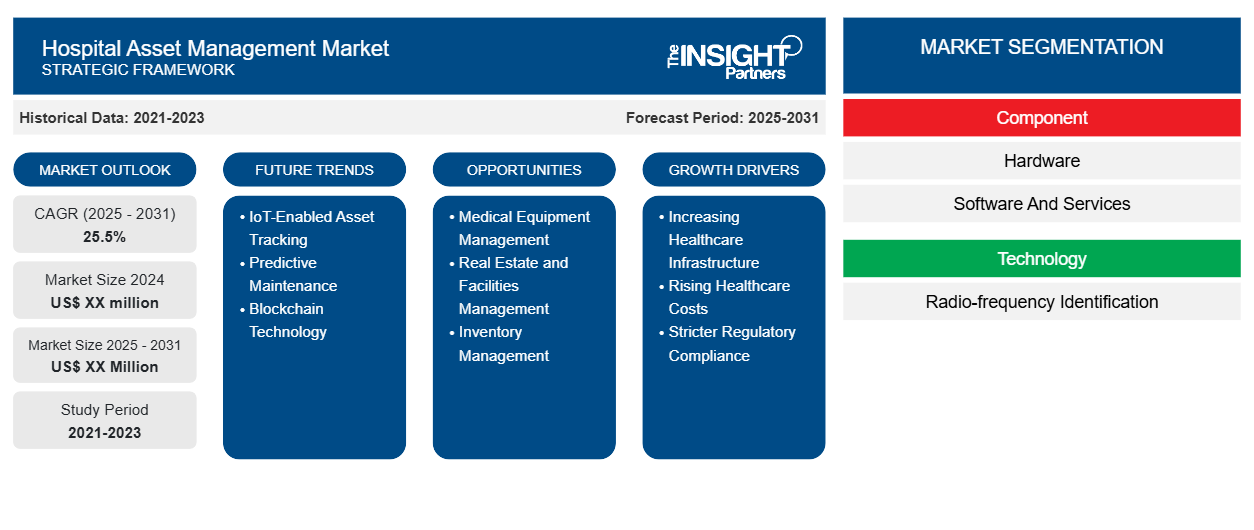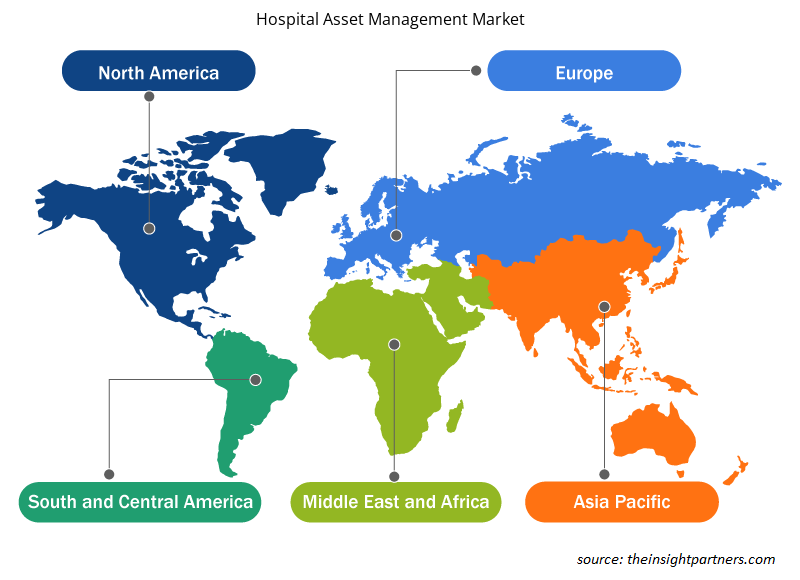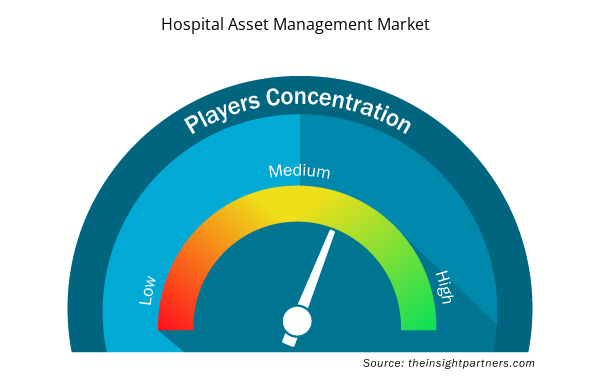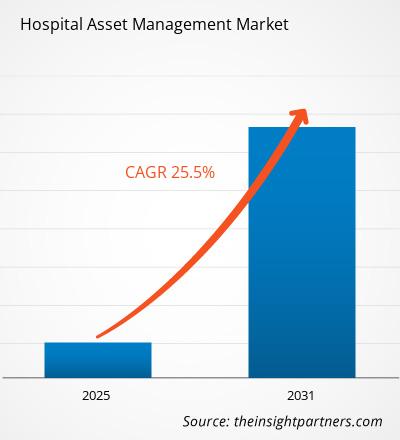Le marché de la gestion des actifs hospitaliers devrait enregistrer un TCAC de 25,5 % de 2025 à 2031, avec une taille de marché passant de XX millions de dollars américains en 2024 à XX millions de dollars américains d'ici 2031.
Le rapport est divisé en quatre sections : Composants (matériel, logiciels et services), Technologie (identification par radiofréquence), Application (gestion des instruments, gestion des patients, gestion du personnel, gestion de la chaîne d'approvisionnement). L'analyse globale est ventilée par région et par pays.
Objet du rapport
Le rapport « Marché de la gestion des actifs hospitaliers » de The Insight Partners vise à décrire le paysage actuel et la croissance future, les principaux moteurs, les défis et les opportunités. Il fournira des informations aux différents acteurs du secteur, notamment :
- Fournisseurs/fabricants de technologies : pour comprendre l’évolution de la dynamique du marché et connaître les opportunités de croissance potentielles, leur permettant de prendre des décisions stratégiques éclairées.
- Investisseurs : réaliser une analyse complète des tendances concernant le taux de croissance du marché, les projections financières du marché et les opportunités qui existent tout au long de la chaîne de valeur.
- Organismes de réglementation : Réglementer les politiques et les activités de police sur le marché dans le but de minimiser les abus, de préserver la confiance des investisseurs et de maintenir l’intégrité et la stabilité du marché.
Segmentation du marché de la gestion des actifs hospitaliers
Composant
- Matériel
- Logiciels et services
Technologie
- Identification par radiofréquence
Application
- Gestion des instruments
- Gestion des patients
- Gestion du personnel
- Gestion de la chaîne d'approvisionnement
Géographie
- Amérique du Nord
- Europe
- Asie-Pacifique
- Amérique du Sud et Amérique centrale
- Moyen-Orient et Afrique
Personnalisez ce rapport en fonction de vos besoins
Vous bénéficierez d'une personnalisation gratuite de n'importe quel rapport, y compris des parties de ce rapport, ou d'une analyse au niveau des pays, d'un pack de données Excel, ainsi que de superbes offres et réductions pour les start-ups et les universités.
Marché de la gestion des actifs hospitaliers : perspectives stratégiques

- Obtenez les principales tendances clés du marché de ce rapport.Cet échantillon GRATUIT comprendra une analyse de données, allant des tendances du marché aux estimations et prévisions.
Facteurs de croissance du marché de la gestion des actifs hospitaliers
- Développement des infrastructures de santé : Le développement des infrastructures de santé, en particulier dans les pays en développement, exige une gestion efficace des actifs.
- Augmentation des coûts des soins de santé : une gestion efficace des actifs peut contribuer à réduire les coûts opérationnels et à améliorer l’efficacité.
- Conformité réglementaire plus stricte : le respect des normes réglementaires nécessite un suivi et une maintenance précis des actifs.
Tendances futures du marché de la gestion des actifs hospitaliers
- Suivi des actifs activé par l'IoT : les appareils IoT peuvent fournir une visibilité en temps réel sur l'emplacement et l'état des actifs.
- Maintenance prédictive : la maintenance prédictive basée sur l’IA peut optimiser les calendriers de maintenance et réduire les temps d’arrêt.
- Technologie Blockchain : la blockchain peut améliorer la sécurité, la transparence et la traçabilité dans la gestion des actifs.
Opportunités du marché de la gestion des actifs hospitaliers
- Gestion des équipements médicaux : suivi et gestion des équipements médicaux pour garantir une utilisation et des performances optimales.
- Gestion immobilière et des installations : Gestion efficace des bâtiments, des infrastructures et des installations hospitalières.
- Gestion des stocks : Optimisation des niveaux de stocks pour réduire les coûts et éviter les ruptures de stock.
Aperçu régional du marché de la gestion des actifs hospitaliers
Les tendances régionales et les facteurs influençant le marché de la gestion d'actifs hospitaliers tout au long de la période de prévision ont été analysés en détail par les analystes d'Insight Partners. Cette section aborde également les segments et la géographie du marché de la gestion d'actifs hospitaliers en Amérique du Nord, en Europe, en Asie-Pacifique, au Moyen-Orient et en Afrique, ainsi qu'en Amérique du Sud et en Amérique centrale.

- Obtenez les données régionales spécifiques au marché de la gestion des actifs hospitaliers
Portée du rapport sur le marché de la gestion des actifs hospitaliers
| Attribut de rapport | Détails |
|---|---|
| Taille du marché en 2024 | XX millions de dollars américains |
| Taille du marché d'ici 2031 | XX millions de dollars américains |
| TCAC mondial (2025 - 2031) | 25,5% |
| Données historiques | 2021-2023 |
| Période de prévision | 2025-2031 |
| Segments couverts | Par composant
|
| Régions et pays couverts | Amérique du Nord
|
| Leaders du marché et profils d'entreprises clés |
|
Densité des acteurs du marché de la gestion des actifs hospitaliers : comprendre son impact sur la dynamique des entreprises
Le marché de la gestion d'actifs hospitaliers connaît une croissance rapide, portée par une demande croissante des utilisateurs finaux, due à des facteurs tels que l'évolution des préférences des consommateurs, les avancées technologiques et une meilleure connaissance des avantages du produit. Face à cette demande croissante, les entreprises élargissent leur offre, innovent pour répondre aux besoins des consommateurs et capitalisent sur les nouvelles tendances, ce qui alimente la croissance du marché.
La densité des acteurs du marché désigne la répartition des entreprises opérant sur un marché ou un secteur particulier. Elle indique le nombre de concurrents (acteurs) présents sur un marché donné par rapport à sa taille ou à sa valeur marchande totale.
Les principales entreprises opérant sur le marché de la gestion des actifs hospitaliers sont :
- Airista Flow, Inc.
- Elpas
- COMPAGNIE D'ÉLECTRICITÉ GÉNÉRALE
- IBM
- InSites intelligents
Avertissement : Les entreprises répertoriées ci-dessus ne sont pas classées dans un ordre particulier.

- Obtenez un aperçu des principaux acteurs du marché de la gestion des actifs hospitaliers
Principaux arguments de vente
- Couverture complète : Le rapport couvre de manière exhaustive l'analyse des produits, des services, des types et des utilisateurs finaux du marché de la gestion des actifs hospitaliers, offrant un paysage holistique.
- Analyse d’experts : Le rapport est compilé sur la base d’une compréhension approfondie des experts et analystes du secteur.
- Informations à jour : Le rapport garantit la pertinence commerciale en raison de sa couverture des informations récentes et des tendances des données.
- Options de personnalisation : ce rapport peut être personnalisé pour répondre aux exigences spécifiques des clients et s'adapter de manière appropriée aux stratégies commerciales.
Le rapport de recherche sur le marché de la gestion d'actifs hospitaliers peut donc contribuer à décrypter et à comprendre le contexte et les perspectives de croissance du secteur. Malgré quelques inquiétudes légitimes, les avantages globaux de ce rapport l'emportent généralement sur les inconvénients.
- Analyse historique (2 ans), année de base, prévision (7 ans) avec TCAC
- Analyse PEST et SWO
- Taille du marché Valeur / Volume - Mondial, Régional, Pays
- Industrie et paysage concurrentiel
- Ensemble de données Excel


- Cosmetic Bioactive Ingredients Market
- Vertical Farming Crops Market
- Real-Time Location Systems Market
- Legal Case Management Software Market
- Asset Integrity Management Market
- Quantitative Structure-Activity Relationship (QSAR) Market
- Frozen Potato Market
- Medical Second Opinion Market
- Flexible Garden Hoses Market
- Fertilizer Additives Market

Report Coverage
Revenue forecast, Company Analysis, Industry landscape, Growth factors, and Trends

Segment Covered
This text is related
to segments covered.

Regional Scope
North America, Europe, Asia Pacific, Middle East & Africa, South & Central America

Country Scope
This text is related
to country scope.
Questions fréquemment posées
Some of the customization options available based on request are additional 3-5 company profiles and country-specific analysis of 3-5 countries of your choice. Customizations are to be requested/discussed before making final order confirmation, as our team would review the same and check the feasibility.
The report can be delivered in PDF/PPT format; we can also share excel dataset based on the request.
The leading players in the Hospital Asset Management Market are: Airista Flow, Inc., Elpas, GENERAL ELECTRIC COMPANY, IBM, Intelligent InSites, Siemens Healthcare GmbH, Sonitor Technologies, STANLEY Healthcare, Vision ID, Zebra Technologies, ThingMagic, CenTrak, Inc., AiRISTA Flow, Sonitor, Elpas
Hospital Asset Managementis expected to grow at a CAGR of 25.5% between 2023-2031
The future trends of the Hospital Asset Management Market are: Expansion of Hospitals, Sensors using the Internet of Things
The driving factors impacting the Hospital Asset Management Market are: Increasing Healthcare Infrastructure Investments, Complex Healthcare Asset Lifecycle Management
Trends and growth analysis reports related to Technology, Media and Telecommunications : READ MORE..
1. Airista Flow, Inc.
2. Elpas
3. GENERAL ELECTRIC COMPANY
4. IBM
5. Intelligent InSites
6. Siemens Healthcare GmbH
7. Sonitor Technologies
8. STANLEY Healthcare
9. Vision ID
10. Zebra Technologies
11. ThingMagic
12. CenTrak, Inc.
13. AiRISTA Flow
14. Sonitor
15. Elpas
The Insight Partners performs research in 4 major stages: Data Collection & Secondary Research, Primary Research, Data Analysis and Data Triangulation & Final Review.
- Data Collection and Secondary Research:
As a market research and consulting firm operating from a decade, we have published and advised several client across the globe. First step for any study will start with an assessment of currently available data and insights from existing reports. Further, historical and current market information is collected from Investor Presentations, Annual Reports, SEC Filings, etc., and other information related to company’s performance and market positioning are gathered from Paid Databases (Factiva, Hoovers, and Reuters) and various other publications available in public domain.
Several associations trade associates, technical forums, institutes, societies and organization are accessed to gain technical as well as market related insights through their publications such as research papers, blogs and press releases related to the studies are referred to get cues about the market. Further, white papers, journals, magazines, and other news articles published in last 3 years are scrutinized and analyzed to understand the current market trends.
- Primary Research:
The primarily interview analysis comprise of data obtained from industry participants interview and answers to survey questions gathered by in-house primary team.
For primary research, interviews are conducted with industry experts/CEOs/Marketing Managers/VPs/Subject Matter Experts from both demand and supply side to get a 360-degree view of the market. The primary team conducts several interviews based on the complexity of the markets to understand the various market trends and dynamics which makes research more credible and precise.
A typical research interview fulfils the following functions:
- Provides first-hand information on the market size, market trends, growth trends, competitive landscape, and outlook
- Validates and strengthens in-house secondary research findings
- Develops the analysis team’s expertise and market understanding
Primary research involves email interactions and telephone interviews for each market, category, segment, and sub-segment across geographies. The participants who typically take part in such a process include, but are not limited to:
- Industry participants: VPs, business development managers, market intelligence managers and national sales managers
- Outside experts: Valuation experts, research analysts and key opinion leaders specializing in the electronics and semiconductor industry.
Below is the breakup of our primary respondents by company, designation, and region:

Once we receive the confirmation from primary research sources or primary respondents, we finalize the base year market estimation and forecast the data as per the macroeconomic and microeconomic factors assessed during data collection.
- Data Analysis:
Once data is validated through both secondary as well as primary respondents, we finalize the market estimations by hypothesis formulation and factor analysis at regional and country level.
- Macro-Economic Factor Analysis:
We analyse macroeconomic indicators such the gross domestic product (GDP), increase in the demand for goods and services across industries, technological advancement, regional economic growth, governmental policies, the influence of COVID-19, PEST analysis, and other aspects. This analysis aids in setting benchmarks for various nations/regions and approximating market splits. Additionally, the general trend of the aforementioned components aid in determining the market's development possibilities.
- Country Level Data:
Various factors that are especially aligned to the country are taken into account to determine the market size for a certain area and country, including the presence of vendors, such as headquarters and offices, the country's GDP, demand patterns, and industry growth. To comprehend the market dynamics for the nation, a number of growth variables, inhibitors, application areas, and current market trends are researched. The aforementioned elements aid in determining the country's overall market's growth potential.
- Company Profile:
The “Table of Contents” is formulated by listing and analyzing more than 25 - 30 companies operating in the market ecosystem across geographies. However, we profile only 10 companies as a standard practice in our syndicate reports. These 10 companies comprise leading, emerging, and regional players. Nonetheless, our analysis is not restricted to the 10 listed companies, we also analyze other companies present in the market to develop a holistic view and understand the prevailing trends. The “Company Profiles” section in the report covers key facts, business description, products & services, financial information, SWOT analysis, and key developments. The financial information presented is extracted from the annual reports and official documents of the publicly listed companies. Upon collecting the information for the sections of respective companies, we verify them via various primary sources and then compile the data in respective company profiles. The company level information helps us in deriving the base number as well as in forecasting the market size.
- Developing Base Number:
Aggregation of sales statistics (2020-2022) and macro-economic factor, and other secondary and primary research insights are utilized to arrive at base number and related market shares for 2022. The data gaps are identified in this step and relevant market data is analyzed, collected from paid primary interviews or databases. On finalizing the base year market size, forecasts are developed on the basis of macro-economic, industry and market growth factors and company level analysis.
- Data Triangulation and Final Review:
The market findings and base year market size calculations are validated from supply as well as demand side. Demand side validations are based on macro-economic factor analysis and benchmarks for respective regions and countries. In case of supply side validations, revenues of major companies are estimated (in case not available) based on industry benchmark, approximate number of employees, product portfolio, and primary interviews revenues are gathered. Further revenue from target product/service segment is assessed to avoid overshooting of market statistics. In case of heavy deviations between supply and demand side values, all thes steps are repeated to achieve synchronization.
We follow an iterative model, wherein we share our research findings with Subject Matter Experts (SME’s) and Key Opinion Leaders (KOLs) until consensus view of the market is not formulated – this model negates any drastic deviation in the opinions of experts. Only validated and universally acceptable research findings are quoted in our reports.
We have important check points that we use to validate our research findings – which we call – data triangulation, where we validate the information, we generate from secondary sources with primary interviews and then we re-validate with our internal data bases and Subject matter experts. This comprehensive model enables us to deliver high quality, reliable data in shortest possible time.

 Obtenez un échantillon gratuit pour ce rapport
Obtenez un échantillon gratuit pour ce rapport